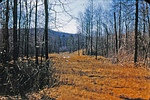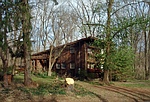Camp Shanks to Indian HIll
Indian Hill is a wooded enclave of thirteen modern houses located west of Closter Road just past the Palisades Parkway crossing. It was created in the early 1950s by a group of World War II veterans living in the converted army barracks of Camp Shanks, then being used by Columbia University as temporary housing for married students. Camp Shanks was expected to close in the next year or so and members of this group wanted to stay in the Palisades area. They looked everywhere in the hamlet and found that most land was too expensive for them, but then discovered a large piece of property along Closter Road, part of a former farm.
It was crossed by an old carriage road called Gerson’s Lane. After incorporating, probably in 1951, as the Rockleigh Woods Cooperative, the group purchased 18 acres of land for $6,400.
The original thirteen families were named: Calt, Dalto, Guttman, Horgan, Kay, Landriau, Ostrowski, Shigeura, Spencer, Stover, Tanaka, Totten, and Woolard. George Kay, an architecture student at Columbia, drew a subdivision plan which divided the land into one-anda- half acre lots for each of the members and land to be sold later. It also showed a proposed private road (Indian Hill Lane) and a public road (Horne Tooke Road) named after an English politician, a man who sympathized with the colonists during the American Revolution, and was imprisoned in 1778 for trying to raise funds for the victims of the British Army at Lexington and Concord. It was Ray Calt who suggested the name, after reading a book about Horne Tooke. He also suggested a name for the private road — The Primrose Path — but that was rejected by the group for the more pedestrian Indian Hill Lane.
Most of the houses were finished by 1956. All have a contemporary look and were designed and built by the owners; each one was different from the others. The owners took advantage of the wooded setting and did not create lawns around the houses. There were no fences between them and no house numbers until the late 1970s.
The whole area became an instant neighborhood where families socialized together and children played freely throughout the property. Before Horne Tooke Road was extended to reach Oak Tree Road, at the end of the decade, everyone used to sled down it, and there was a steep bobsled run below the Guttmans’ house.
Yuri Shigeura, who still lives in the house that she and her husband built in the 1950s, recalls, “Most of the 13 families brought shared experiences from their years at Shanks Village, where the concept for a Rockleigh Woods Cooperative was born. The communal feeling of neighborliness was transplanted almost seamlessly onto Indian Hill Lane. The children were mostly within the same age-range and knew the secure, somewhat insulated childhood of shared birthday parties, the fun of sledding down the steep hill at the end of the carriage road, hunting for dace and tadpoles in the creek, touch-football games on the street, the adult get-togethers.”
Only two of the original settlers still live in Indian Hill: Yuri Shigeura and Lee Guttman. Lee told me that her husband Paul created a temporary construction company called Palisades Contractors so that he could buy a Scholz pre-cut home, and then put it together himself. It is still a very attractive house and has held up well.
New people have come to replace those who left, but the original unspoiled character of Indian Hill remains.






